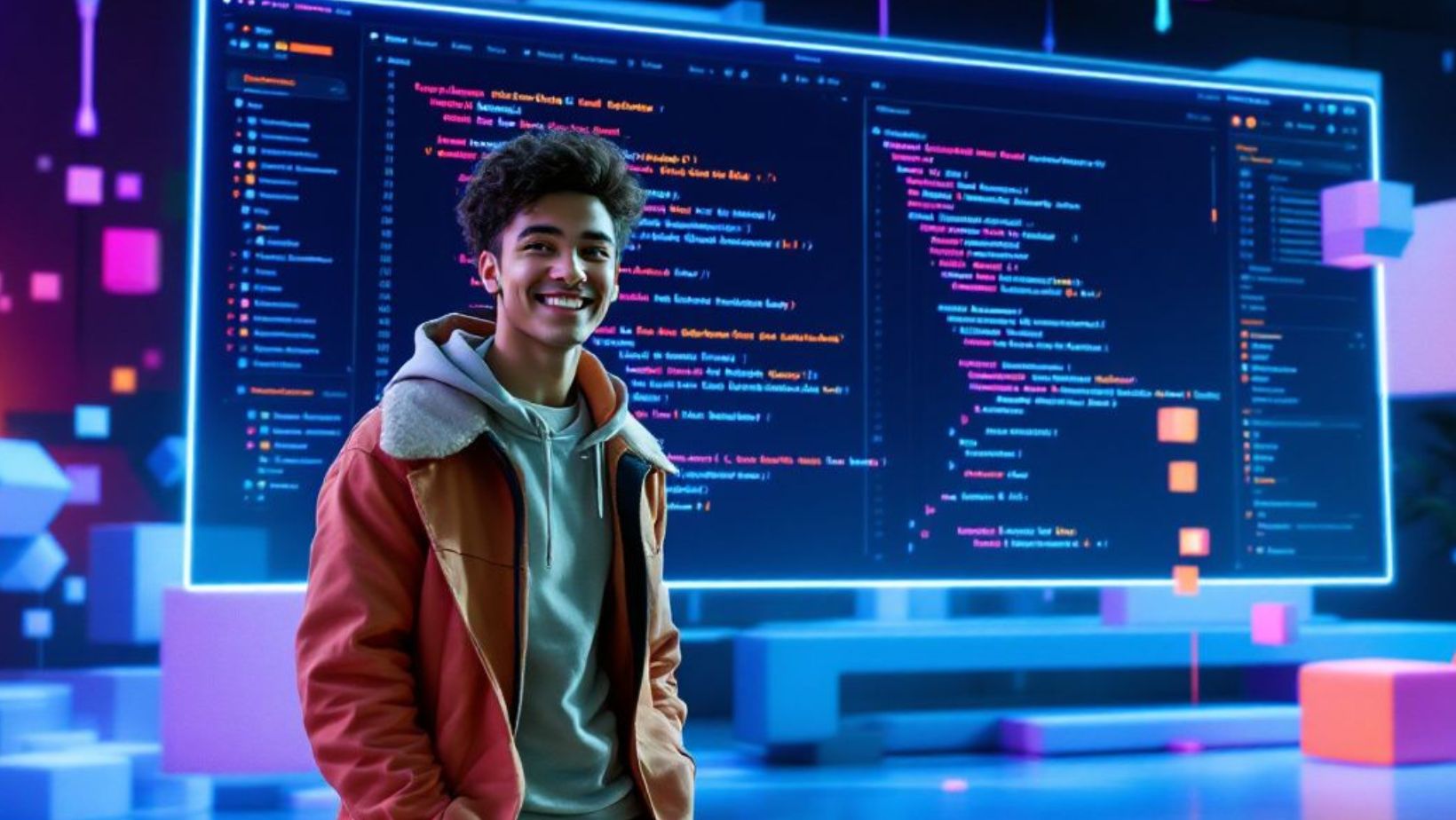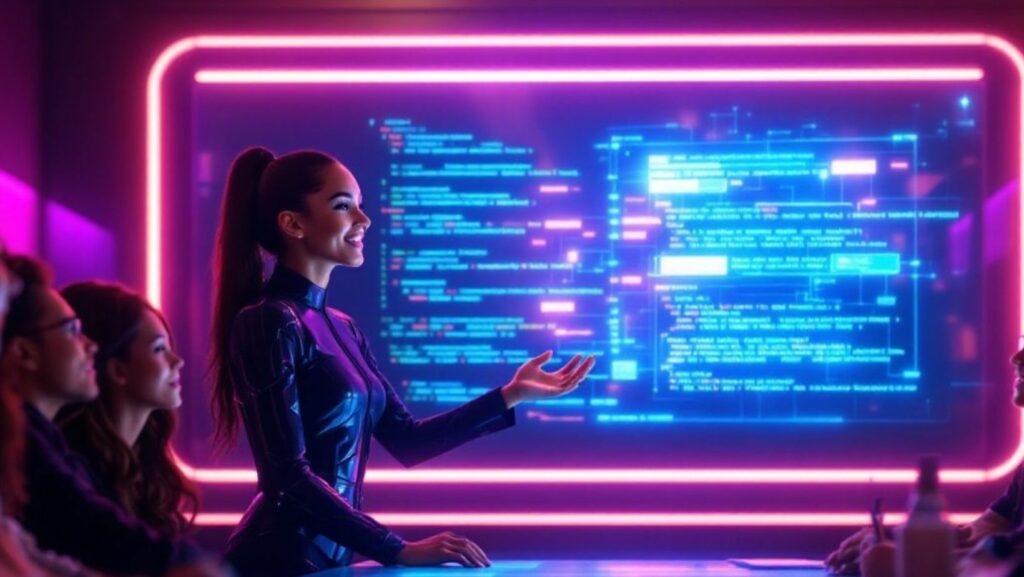Enhancing Python tutorials with video content makes learning more engaging and effective. Videos can simplify complex concepts, cater to different learning styles, and offer a dynamic way to understand Python programming. In this article, you’ll discover the benefits of incorporating video into your tutorials and get practical tips for creating impactful video content.
Key Takeaways
- Video tutorials enhance Python learning by simplifying complex concepts and catering to diverse learning styles such as auditory, visual, and kinesthetic.
- Proper preparation, including outlining content, creating relatable code examples, and scripting, is essential for delivering clear and engaging video tutorials.
- Effective publishing and SEO strategies, along with audience engagement, are crucial for maximizing the reach and impact of Python tutorial videos.
Importance of Video Content in Python Tutorials
What if dubbing videos into multiple languages could be as simple as a few clicks, all while ensuring seamless lip-sync and voice alignment? That’s exactly what Rask AI specializes in — a cutting-edge platform leading the way in automatic dubbing and video translation technologies. This innovative tool enables businesses, creators, and educators to easily produce multilingual video content, streamlining the localization process like never before. In this article, prepared by the experts at Rask AI, we’ll explore key insights and strategies to help your video content go global.
Why are video tutorials so essential for learning the Python programming language? For starters, video content can simplify complex processes, making them easier to understand. Short videos can convey information more effectively than lengthy written explanations, which is a boon for today’s busy learners. Plus, the engaging energy of an instructor can make the learning experience more enjoyable, fostering a deeper connection with the material.
Before:
Different learners benefit from different approaches. For instance, some people are auditory learners who find listening to explanations more effective than reading them. Video tutorials cater to these learners by providing audio content that can be listened to repeatedly, aiding memory. Visual learners, on the other hand, benefit from seeing tasks demonstrated. Video tutorials allow these learners to pause and replay segments, ensuring they grasp each concept thoroughly. Then there are kinesthetic learners who learn best by doing—following along with video tutorials provides them with the hands-on experience they need to reinforce what they’ve learned.
After:
Different learners benefit from different approaches:
- Auditory learners find listening to explanations more effective than reading them. Video tutorials cater to these learners by providing audio content that can be listened to repeatedly, aiding memory.
- Visual learners benefit from seeing tasks demonstrated. Video tutorials allow these learners to pause and replay segments, ensuring they grasp each concept thoroughly.
- Kinesthetic learners learn best by doing. Following along with video tutorials provides them with the hands-on experience they need to reinforce what they’ve learned.
The flexibility of video content cannot be overstated. Learners can pause, rewind, and replay videos as many times as they need, tailoring the experience to their learning pace. This mixed approach to learning is particularly effective for mastering the intricacies of Python programming. Imagine a video that visually demonstrates how to set up a web scraping tool, coupled with an instructor’s enthusiastic narration and a hands-on coding exercise. This combination not only makes the material more accessible but also more memorable.
Moreover, video tutorials provide a hands-on experience that enhances learning retention. Seeing code written in real-time and understanding the rationale behind each step can make a world of difference compared to reading static documentation or textbooks. This hands-on approach is invaluable in programming, where practical application of knowledge is key to mastering the language.
Leveraging video in Python tutorials can cater to diverse learning styles and improve the overall educational experience. This dynamic approach not only makes learning Python more engaging but also more effective, helping learners of all types achieve their goals in mastering the language.
Preparing Your Python Tutorial Content
Meticulous preparation of your Python tutorial content is essential before starting video production. Mastering the fundamentals of Python programming ensures that your tutorials are clear, comprehensive, and valuable to your audience. This preparation phase involves outlining key concepts, creating code examples, and developing a script to guide your presentation.
Outlining Key Concepts
Creating a structured outline of programming concepts is the first step in ensuring clarity and completeness in your tutorial content.
Organizing content into distinct sections simplifies the process for viewers, making each concept easier to grasp. For example, you might start with:
- The basics of data types
- Control structures
- More advanced topics like data analysis
- Data science
- Web development

This structured approach helps in maintaining a logical flow and keeps the content focused and concise.
Integrating quizzes and coding exercises within the tutorials is another effective way to reinforce learning and assess understanding. Quizzes can consist of multiple-choice questions that test the viewer’s grasp of the material, while coding exercises provide hands-on practice. This interactive element not only reinforces knowledge retention but also provides instant feedback, helping learners identify areas where they need further practice.
Creating Code Examples
Planning your code examples ahead of time is essential for clarity and helps viewers grasp the concepts being taught. Use real-world scenarios and small projects to illustrate how Python can solve practical problems. For instance, you could demonstrate how to use Python libraries for data analysis by working through a dataset and extracting meaningful insights. These relatable examples make the content more engaging and easier to understand.
Visual tools such as diagrams and infographics can also simplify complex Python topics. Screencasts, where you record your screen while explaining the code, can enhance written documentation by providing a visual and auditory learning experience. This combination of visual and auditory elements caters to different learning styles and makes the tutorial more comprehensive.
Developing a Script
Writing a detailed script is crucial for delivering a smooth and engaging presentation during your video tutorials. A well-prepared script ensures that you cover all necessary topics systematically, reducing the chances of missing important points.This preparation not only helps in maintaining a logical flow but also increases your confidence while presenting, making the delivery more natural and engaging.
Additionally, using a text summarizer can help refine your script by condensing lengthy sections while retaining key points. This ensures clarity and keeps the presentation concise, making it easier for viewers to absorb the information without feeling overwhelmed.
Having a script also helps in managing anxiety and staying on topic. It provides a roadmap that guides the presentation, ensuring that you address all critical aspects of the material. This structured approach makes the tutorial more professional and easy to follow for the viewers.
Setting Up for High-Quality Video Recording
Setting up for high-quality video recording is crucial for capturing engaging and professional-looking Python tutorials. This involves choosing the right tools, optimizing your workspace, and ensuring good lighting and sound quality. Each of these elements plays a vital role in creating a seamless viewing experience for your audience.
Choosing the Right Tools
Selecting the right screen recording software can significantly impact the quality of your Python tutorials. Popular tools like OBS Studio, Camtasia, and Screencast-O-Matic offer features such as webcam overlay, audio mixing, and easy sharing options. Screencastify is another widely used tool in educational settings, known for its simple interface and integration with Google services.
Having a flexible setup in your workspace allows you to adapt to various shooting conditions and formats. Establishing a designated ‘green room’ area ensures on-camera talent has quick access to refreshments and comfort, further enhancing the recording experience.
Optimizing Your Workspace
Optimizing your workspace is essential for ensuring clear video quality during recordings. Controlling lighting is crucial, and using blackout curtains can help manage natural light effectively. Maintaining focus during recording sessions is important for delivering a smooth presentation.
Using bullet points in your scripts can help streamline your delivery and keep you focused on key topics related to file handling.
Ensuring Good Lighting and Sound
Good audio quality is essential for maintaining viewer engagement and comprehension. Testing your audio setup before recording is crucial to avoid technical issues during shoots. A minimalistic lighting setup can still achieve professional results as long as it meets your specific video goals. Choosing the right lighting rig involves considering the balance between ease of use and creative flexibility.
In addition to lighting, ensuring good sound quality is vital. Investing in a quality microphone and conducting test recordings can help identify potential issues early. This preparation ensures that your final videos are polished and professional, enhancing the overall viewer experience.
Recording and Editing Your Python Tutorial Videos
Recording and editing your Python tutorial videos effectively is crucial for delivering a seamless learning experience. Well-documented code examples play a significant role in demonstrating Python concepts clearly and effectively.
Making a Test Recording
Performing test recordings helps identify potential issues early, ensuring smoother final outputs. Practicing the script aloud can enhance your delivery and build confidence, making the actual recording process more efficient.
Using Screen Recording Software
Popular screen recording tools like OBS Studio, Camtasia, and Screencast-O-Matic offer unique capabilities that can enhance your Python tutorial videos. Key features to look for include screen capture quality, audio recording capabilities, and the ability to capture specific application windows. Effective screen recording software should also provide editing options such as trimming and adding annotations.
Integration with other software and the capability to share videos directly to platforms like YouTube adds significant value for tutorial creators. For beginners, tools like Screencast-O-Matic offer simplified interfaces and guided workflows to facilitate the recording process.
Basic Editing Techniques
Defining the outcome before recording helps in structuring the video effectively. Basic editing involves trimming clips, adding text annotations, and improving sound quality to enhance the overall tutorial. Utilizing these basic editing techniques can lead to more polished and professional-looking tutorial videos.
Cutting unnecessary segments, adding text overlays, and improving audio clarity are essential steps in the editing process. These basic techniques ensure that the final product is concise, clear, and engaging for the viewers.
Enhancing Engagement with Interactive Elements
Incorporating interactive elements in your Python tutorial videos can significantly enhance learner engagement and understanding. This section will explore how to integrate quizzes, visual aids, and viewer interaction to make your tutorials more engaging.
Incorporating Quizzes and Exercises
Incorporating quizzes at the end of each concept can enhance viewer engagement and facilitate better retention of the material. These quizzes can consist of multiple-choice questions that test the viewer’s understanding and provide instant feedback. The integration of quizzes in Python tutorial videos can greatly enhance the learning experience for viewers, helping them reinforce their knowledge and identify areas where they need further practice.

Including coding exercises is another effective way to engage learners. These hands-on tasks allow viewers to apply what they’ve learned in practical scenarios, further cementing their understanding. Completing these exercises helps learners build confidence in their coding skills and deepen their understanding of Python programming. If you want to enhance your skills, you should learn python.
Using Visual Aids
Visual aids are essential in making complex concepts easier to understand. Tools with features like webcam overlays and annotation capabilities can enhance your tutorials. For instance, visualizing code outputs or using infographics can help learners grasp valuable skill concepts more effectively.
Descriptive language can also enhance understanding for viewers with visual impairments.
Encouraging Viewer Interaction
Regularly interacting with viewers by responding to comments fosters a sense of community and encourages viewer loyalty. Responding to comments can create a stronger sense of community and increase viewer engagement. Incorporating viewer feedback can lead to improved content quality and increased viewer satisfaction.
Engaging with viewers through comments and live streams can create a more interactive and dynamic learning environment. This interaction can also provide valuable insights into what viewers find helpful, allowing you to tailor future content to better meet their needs.
Publishing and Promoting Your Python Tutorial Videos
Publishing and promoting your Python tutorial videos effectively is crucial for reaching a wider audience and maximizing impact.
This section will explore the best platforms for hosting your content and strategies for optimizing SEO to increase visibility.
Choosing the Right Platforms
Choosing the right platform for publishing your Python tutorial videos can significantly impact your reach and visibility. YouTube is a preferred platform due to its vast audience and ease of sharing content. Additionally, YouTube offers features like monetization and a broad user base, making it an attractive option for tutorial creators. However, YouTube’s large audience also means greater competition, so optimizing your content for search visibility is essential.
On the other hand, platforms like Udemy provide a more structured approach, allowing creators to offer comprehensive courses. Udemy’s framework includes built-in marketing tools and a dedicated audience looking for educational content. While Udemy’s structured environment can be beneficial, it often involves adhering to their pricing strategies and standards, which may not suit everyone.
Ultimately, the choice of platform depends on your content style, goals, and target audience.
SEO Strategies for Video Content
Implementing effective SEO strategies for your video content is crucial for enhancing search engine ranking and visibility. Incorporating relevant keywords in your video titles, descriptions, and tags can significantly improve search visibility. For instance, using targeted keywords like “Python programming language” or “Python tutorials” in your titles can attract a more relevant audience. Additionally, video descriptions should start with important information and include keywords to improve ranking on search engines.

Using tags helps categorize your videos, making them easier to discover on platforms like YouTube. Including a mix of broad and specific tags can enhance your video’s discoverability. For example, combining tags like “Python programming” with more niche tags like “Python data analysis tutorial” can help attract a diverse audience.
Optimizing your video content for SEO increases the chances of reaching a wider audience and boosting engagement.
Engaging with Your Audience
Engaging with your audience is essential for building a loyal community around your Python tutorials. Encouraging viewers to engage through comments and questions fosters a sense of community and enhances the learning experience. Prompting viewers to leave comments, ask questions, and share their thoughts can create a more interactive and dynamic environment.
Utilizing discussion boards and community forums can further enhance interaction and provide additional support for learners. These learning platforms allow learners to share their experiences, ask for help, and collaborate on projects, creating a collaborative learning environment.
Engaging with your audience not only helps build a loyal following but also provides valuable insights into what viewers find helpful, allowing you to improve your content continuously.
Leveraging AI for Video Localization
Leveraging AI for video localization can significantly broaden your audience reach and enhance viewer engagement. Rask AI offers intelligent solutions for automating video translation and dubbing, making your content accessible to a global audience.
Localizing your videos caters to diverse linguistic and cultural backgrounds, making your Python tutorials more relatable and impactful.
Benefits of Video Localization
Localizing your video content can significantly enhance viewer engagement by making it culturally relevant and accessible to diverse audiences. This approach not only broadens your audience reach but also makes your content more relatable to viewers from different cultural backgrounds. For example, translating your Python tutorials into multiple languages can attract learners from around the world, increasing your content’s impact and visibility.
Furthermore, localization can enhance the overall learning experience by catering to viewers’ linguistic preferences. Providing content in learners’ native languages simplifies understanding of complex concepts and enhances engagement with the material. This personalized approach can significantly boost viewer satisfaction and retention.
Using Rask AI for Localization
Rask AI provides powerful services designed to enhance the localization process for video content, making it accessible for a global audience. These services are available in-app and via API, allowing users to choose the best method for their localization needs.

With Rask AI, you can efficiently translate and dub your real python tutorials into over 130 languages, ensuring that your content reaches a wider audience and has a greater impact.
Summary
In summary, creating engaging Python tutorial videos involves meticulous preparation, high-quality recording, effective editing, and strategic promotion. By leveraging interactive elements and AI-powered localization tools like Rask AI, you can significantly enhance the learning experience and broaden your audience reach. Embrace these strategies to transform your Python tutorials into dynamic and impactful learning resources that resonate with viewers worldwide.
Frequently Asked Questions
What to do After Watching the Python Tutorial?
After watching a Python tutorial, it’s crucial to deepen your skills by practicing coding projects or exploring advanced topics like web development or machine learning. Choose a path that aligns with your interests to effectively advance your programming career.
Why are Video Tutorials Important for Learning Python?
Video tutorials are important for learning Python as they simplify complex concepts and cater to various learning styles, offering hands-on experience that enhances understanding and retention. This interactive approach often proves more effective than traditional written explanations.
How can I Prepare My Content for Python Tutorial Videos?
To prepare your content for Python tutorial videos, focus on mastering the fundamentals, outlining key concepts, and creating clear code examples. Additionally, develop a detailed script to ensure a smooth and structured presentation.
What Tools Should I Use for Recording High-quality Python Tutorial Videos?
For recording high-quality Python tutorial videos, utilize screen recording software like OBS Studio, Camtasia, or Screencast-O-Matic, while also ensuring optimal lighting and sound quality. This combination will significantly enhance the overall quality of your tutorials.
How can I Enhance Engagement in my Python Tutorial Videos?
To enhance engagement in your Python tutorial videos, incorporate quizzes, visual aids, and interactive elements while actively engaging with your audience through comments and live streams. This approach fosters a sense of community and encourages viewer participation.


